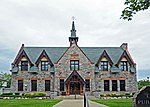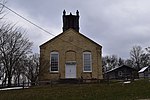Glacial Drumlin State Trail
Protected areas of Dane County, WisconsinProtected areas of Jefferson County, WisconsinProtected areas of Waukesha County, WisconsinRail trails in Wisconsin

The Glacial Drumlin State Trail is a multipurpose rail trail in the U.S. State of Wisconsin. It stretches 52 miles (84 km) from Waukesha (near Milwaukee) to Cottage Grove (near Madison). The trail travels through or near the Wisconsin communities of Cottage Grove, Deerfield, London, Lake Mills, Jefferson, Helenville, Sullivan, Dousman, Genesee, Wales, and Waukesha. In Lake Mills, it crosses Rock Lake on one of its many old railroad bridges. The trail was opened in 1986 and follows the old Chicago and North Western Railway (C&NW) Madison–Milwaukee mainline.The name refers to a drumlin, a glacial landform very common in the area.
Excerpt from the Wikipedia article Glacial Drumlin State Trail (License: CC BY-SA 3.0, Authors, Images).Glacial Drumlin State Trail
Glacial Drumlin State Trail,
Geographical coordinates (GPS) Address Website External links Nearby Places Show on map
Geographical coordinates (GPS)
| Latitude | Longitude |
|---|---|
| N 43.064166666667 ° | E -88.913333333333 ° |
Address
Glacial Drumlin State Trail
Glacial Drumlin State Trail
53551
Wisconsin, United States
Open on Google Maps








